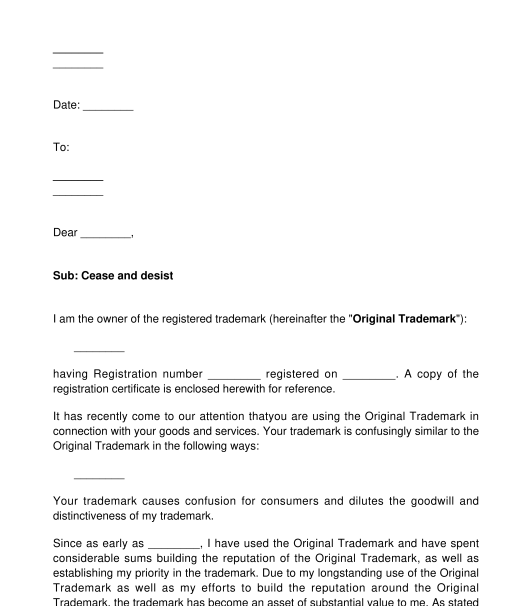 27-09-2025
27-09-2025

Answer a few questions and your document is created automatically.

Your document is ready! You will receive it in Word and PDF formats. You will be able to modify it.

 27-09-2025
27-09-2025
 Word and PDF
Word and PDF
 1 to 2 pages
1 to 2 pages
A Cease and Desist Letter is a letter sent to an individual or business that is engaging in unwelcome or illegal behaviour. The Cease and Desist acts as a formal request that the recipient stop ("cease") and not continue ("desist") this behaviour. If the recipient of the letter fails to comply with these demands, the sender should be prepared to take further legal action to stop the behaviour that is harming or interfering with the sender's rights and abilities to conduct business.
This Cease and Desist letter should be used in cases of Trademark or Copyright infringement cases.
A trademark is a way of identifying a unique product or service - such as a 'brand', a logo, letter, number, phrase, word, sound, smell, shape, picture, movement, type of packaging, or some combination of these.
Another common form of intellectual property infringement is copyright infringement. Copyrights relate to creative works, such as pieces of writing, music, or artwork. Copyright law protects work with a 'creative' element, such as literary, dramatic, musical, and artistic works.
A cease and desist letter may be an effective way to amicably settle and enforce the rights of owners of copyrights and trademarks before initiating legal action. If the matter ends up in court, a Cease and Desist letter can be used to show that the recipient was put on notice about their offending behaviour, so the more detailed the letter, the better.
This letter is for trademark or copyright infringements or violations. For other types of cease and Desist letters, a General Cease and Desist Letter is available.
A Cease and Desist letter includes the following basic elements:
Once the letter has been completed, it can be sent either through email, registered post, or in person to the individual or business that has been conducting the offensive behaviour.
There are no laws outlining what must be included in a Cease and Desist letter. However, best practices dictate that a Cease and Desist include a detailed description of the offending behaviour and a clear demand that the behaviour stop, or else legal action will be taken.
The Trade Marks Act 1999 may be relevant to this matter, in particular, if the offending behaviour does not stop and further action becomes necessary. In addition, the Copyrights Act 1957, may be relevant in cases of copyright violation. In some cases, publishing offensive illegal content on the internet may violate the Information Technology Act, of 2000.
You fill out a form. The document is created before your eyes as you respond to the questions.
At the end, you receive it in Word and PDF formats. You can modify it and reuse it.
Country: India